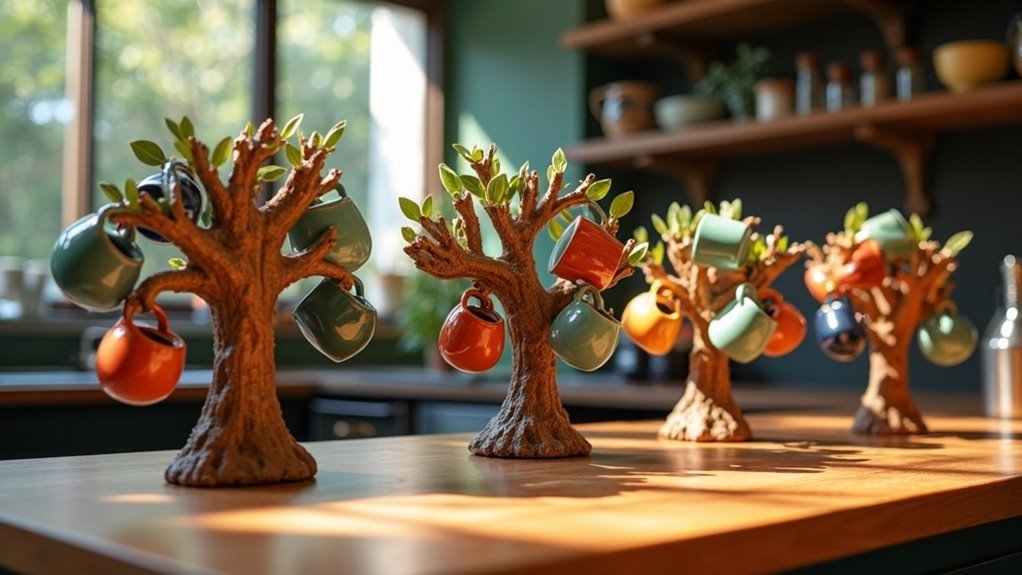Singaporean kopi is more than just coffee; it’s a vibrant part of the city’s culture. With over 54 variations, you can enjoy a sweet, creamy cup made with condensed milk or a bold black coffee. Traditionally brewed using unique methods, kopi reflects Singapore’s rich, multicultural heritage, and serves as a social hub in kopitiams. Each cup fosters connections among patrons. If you’re curious to learn more about this beloved beverage, its history, and how to order, keep exploring!
Key Takeaways
- Singaporean kopi is a traditional coffee style that reflects the multicultural heritage of the country, particularly popularized by the Hainanese community.
- There are over 54 variations of kopi, including Kopi, Kopi O, and Kopi C, each characterized by unique preparation methods and ingredients.
- The base of kopi is primarily made from Indonesian Robusta beans, which are known for their high caffeine content and robust flavors.
- Kopitiams, or coffee shops, serve as social hubs where people come together to enjoy kopi alongside local snacks like kaya toast and soft-boiled eggs.
- While enjoying kopi can be a delightful experience, it is important to note that it contains high levels of caffeine and sugar, so mindful consumption is advised for health considerations.
Etymology and Cultural Significance
While you may simply enjoy a cup of coffee, delving into the origins of Singaporean kopi unveils a rich cultural narrative.
The word “kopi,” derived from Malay, is influenced by Hokkien, showcasing Singapore’s multicultural heritage.
Kopi reflects Singapore’s rich multicultural heritage, blending Malay roots with Hokkien influence in every cup.
Originating during the British Malaya period, the Hainanese community was instrumental in popularizing kopitiams, the local coffee shops where people gather to enjoy their favorite brew.
This cherished drink has become an integral part of Singapore’s identity, with over 70% of coffee consumed being kopi.
It goes beyond mere refreshment; it nurtures social bonds and community interactions, with each cup symbolizing unity amidst the bustling urban environment.
Variations of Kopi
When you explore the variations of Singaporean kopi, you’ll uncover a delightful array of choices that cater to diverse coffee enthusiasts.
With at least 54 core variations, you can tailor your drink based on sugar levels and ingredients to suit your taste. You might savor a classic Kopi, sweetened with condensed milk, or opt for a bold black Kopi O with sugar.
If you crave a creamy texture, try Kopi C, which is made with evaporated milk and sugar. For a refreshing twist, there’s Kopi peng, an iced coffee blended with sugar and condensed milk.
Each order reflects local dialects, showcasing Singapore’s rich multicultural heritage. Your perfect cup of kopi awaits!
Processing Methods
When you think about how Singaporean kopi is crafted, the traditional roasting techniques stand out, blending coffee beans with sugar and margarine for a unique flavor.
You’ll appreciate the rich brew that comes from using a cloth sock filter, which not only infuses the coffee but also enhances its bold taste.
Each cup showcases careful processing methods, ensuring that every sip delivers a delightful coffee experience.
Traditional Roasting Techniques
As you explore the world of Singaporean kopi, you’ll discover that traditional roasting techniques play a pivotal role in crafting its unique flavor.
Here’s what makes the roasting process special:
- Robusta Beans: Primarily Indonesian Robusta beans are used for their high caffeine content and flavor adaptability.
- Unique Mix: The beans are combined with 20% sugar and margarine, roasted for 25 minutes to caramelize without burning.
- Flavor Enhancement: A pinch of salt is added to enrich the sweet aroma, creating the perfect ground coffee for traditional coffee shops.
This heritage technique shapes the distinctive coffee experience cherished in Singapore, making it a true highlight for coffee enthusiasts.
Brewing With Sock Filter
The unique flavor of Singaporean kopi comes to life through the traditional brewing method using a sock filter. This cloth sack infuses robust Indonesian coffee beans, primarily Robusta, creating a rich, concentrated brew. The roasting process caramelizes the beans with sugar and margarine, enhancing the flavor profile. After brewing, you mix the concentrated coffee with canned dairy, sugar, and water for a creamy delight. Here’s a quick breakdown:
| Step | Description |
|---|---|
| Brewing Method | Sock filter brewing |
| Coffee Type | Primarily Robusta |
| Roasting Time | About 25 minutes |
| Additions | Canned dairy, sugar, water |
| Cultural Impact | Influenced by Hainanese immigrants |
This website celebrates the art of coffee brewing and the rich traditions associated with it.
Flavor Enhancement Methods
While exploring Singaporean kopi, you’ll discover that flavor enhancement goes beyond just brewing techniques. The unique preparation methods elevate its taste.
Here are three key enhancements:
- Roasting Process: The combination of 80% Robusta beans with 20% sugar and margarine, roasted for 25 minutes, creates a rich caramelization that deepens the coffee’s flavor.
- Salt Addition: A pinch of salt during roasting intensifies the flavor profile, perfectly balancing the sweetness and bitterness for a more complex taste.
- Customization: You can adjust sugar levels, thickness, and milk types to personalize your coffee experience, ensuring each cup is uniquely satisfying.
These methods contribute to kopi’s bold character, making every sip a delightful adventure in the world of coffee.
History of Kopitiam Coffee
Kopitiam coffee has roots in Singapore’s late 18th century, where a vibrant blend of European and Asian coffee cultures sparked its popularity as a social hub.
As you explore its evolution, you’ll notice how brewing techniques shifted from Arabica to robust Robusta beans, creating a bold flavor that stands out.
These coffee shops not only transformed their purpose after the gambling ban in 1829, but also became a delicious reflection of Singapore’s rich cultural fusion.
The unique preparation methods and the communal atmosphere of Kopitiam make it a quintessential part of the coffee experience in Singapore.
Cultural Fusion Origins
Emerging in the late 18th century, kopitiam coffee embodies a fascinating blend of European and Asian influences that took shape during the British colonial period in Southeast Asia.
This cultural fusion gave rise to unique practices and tastes you can still enjoy today:
- The shift to robust Robusta beans, favored for their resilience in Southeast Asia’s climate, has become a hallmark of kopitiam coffee.
- The introduction of sock filters provides a clever brewing method that showcases the ingenuity behind this beloved beverage.
- The delightful mix of Eastern and Western breakfast items, such as kaya jam, complements the kopi experience, making it a true culinary delight.
Kopitiam coffee isn’t just a drink; it’s a reflection of Singapore’s rich cultural tapestry and a testament to the artistry of coffee-making.
Social Hubs Evolution
In the bustling streets of Singapore, many people find solace in the vibrant atmosphere of kopitiams, which have evolved from simple coffee shops into essential social hubs centered around coffee culture.
Originating in the late 18th century, these spaces blended European and Asian influences, fostering a unique kopitiam coffee scene. Once known for illegal activities, they transformed after regulations in 1829, allowing them to focus on their primary offering: coffee.
Today, you can savor a cup of rich kopi alongside delicious kaya toast, a delightful pairing that showcases their evolving menus.
However, modern challenges like competition and rising costs threaten their legacy, making it vital for future generations to appreciate and sustain these beloved coffee-centric community spots.
Brewing Techniques Transition
With a rich history that intertwines culture and community, the brewing methods of Singaporean coffee have seen remarkable evolution over the centuries.
You’ll find that:
- Sock filters revolutionized brewing, enhancing flavor and adapting to the lack of traditional appliances.
- Strong Robusta beans became the staple, thriving in the Southeast Asian climate and replacing the traditional Arabica beans.
- Modern coffee shops face challenges from rising costs and competition, leading to adaptations in brewing techniques and food preparation.
This blend of tradition and innovation reflects the vibrant spirit of coffee and its role in bringing communities together.
Culinary Offerings at Kopitiams
As you step into a kopitiam, you’ll be greeted by the rich aroma of freshly brewed coffee that defines the heart of these vibrant establishments.
The experience isn’t just about the coffee itself, but also the unique ways it’s enjoyed. You can savor traditional kopi, which is often sweetened with condensed milk or sugar, served alongside delectable bites like kaya toast slathered in rich coconut jam or soft-boiled eggs drizzled with soy sauce.
Each kopitiam showcases its own signature brew, reflecting the diverse backgrounds of the operators. Beyond just a caffeine fix, these social hubs celebrate the art of coffee, fostering community and connection through shared flavors and conversations.
Health and Nutrition Considerations
While kopitiams are cherished for their lively atmosphere and delicious offerings, it’s important to consider the health and nutrition aspects of your favorite coffee.
Here are a few key points to keep in mind:
- Caffeine Content: Kopi contains about twice the caffeine of Arabica coffee, making it a potent choice for an energy boost.
- Sugar Levels: A standard cup typically contains three teaspoons of sugar, adding to its sweetness and calorie count, which can approach the WHO’s recommended limits.
- Evaporated Milk: This ingredient enhances the drink’s creaminess but also contributes additional calories and fats.
Stay informed to enjoy your coffee responsibly!
Modern Challenges and Adaptations
Though kopitiams have long been a staple of Singapore’s vibrant coffee culture, they’re now grappling with modern challenges that threaten their survival.
Increased competition from larger coffee chains pushes traditional kopitiams to innovate, attracting customers with refined brewing techniques and diverse coffee menu options. Rising labor costs and new regulations complicate efforts to maintain profitability, leaving some owners struggling to keep their doors open.
Furthermore, a generational shift means fewer young adults are entering the kopitiam business, raising concerns about this cultural coffee staple’s future.
Despite these hurdles, kopitiams continue to serve as essential social hubs, showcasing their resilience in the ever-evolving coffee landscape.
How to Order Traditional Kopitiam Coffee
Ordering coffee at a kopitiam is an experience steeped in tradition and local flavor, especially when you know the right terms to use. Here’s how to navigate your order:
Ordering coffee at a kopitiam immerses you in local culture, especially when you master the unique lingo.
- Kopi – This is coffee served with sweetened condensed milk; it’s a must-try for any coffee lover!
- Kopi C – Ideal for those who prefer evaporated milk, with sugar included for a delightful sweetness.
- Kopi Peng – This is iced coffee; remember to ask for “sutai” if you prefer it less sweet.
With these terms in hand, you’ll feel right at home.
Just keep in mind that some kopitiams may not offer English menus, so embracing the local dialect will enhance your coffee experience!








